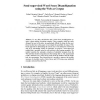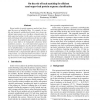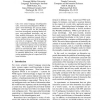118 search results - page 5 / 24 » Unlabeled data improves word prediction |
102
Voted
CICLING
2009
Springer
15 years 6 months ago
2009
Springer
Abstract. As any other classification task, Word Sense Disambiguation requires a large number of training examples. These examples, which are easily obtained for most of the tasks,...
BIBM
2008
IEEE
15 years 1 months ago
2008
IEEE
Recent studies in protein sequence analysis have leveraged the power of unlabeled data. For example, the profile and mismatch neighborhood kernels have shown significant improveme...
94
Voted
CVPR
2007
IEEE
16 years 1 months ago
2007
IEEE
Current methods for learning visual categories work well when a large amount of labeled data is available, but can run into severe difficulties when the number of labeled examples...
SDM
2009
SIAM
15 years 8 months ago
2009
SIAM
The annotation of words and phrases by ontology concepts is extremely helpful for semantic interpretation. However many ontologies, e.g. WordNet, are too fine-grained and even hu...
102
click to vote
NAACL
2010
14 years 9 months ago
2010
Like most natural language disambiguation tasks, word sense disambiguation (WSD) requires world knowledge for accurate predictions. Several proxies for this knowledge have been in...




